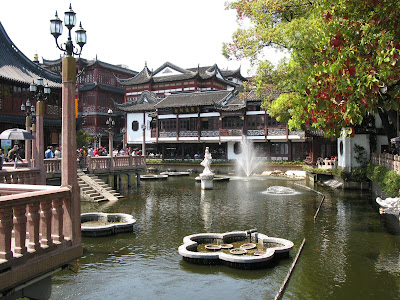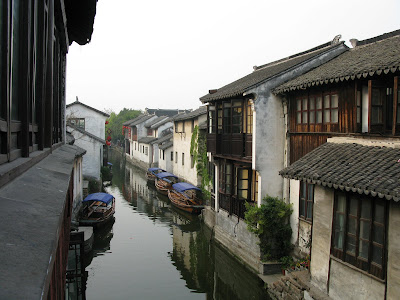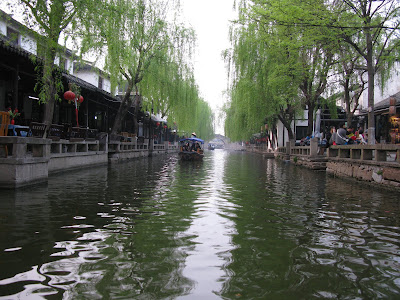I apologize for not publishing any entries in the blog over the last two weeks, but we have been in China where blogging is illegal. All blog sites are blocks by the Chinese Government in an attempt to ensure that the dreaded social media does not topple their government, as it seems to be doing in most other places these days. Rest assured, though, I kept copious mental notes with which to regale forthwith.
We left a week ago Wednesday on our Chinese endeavor the purpose of which was actually work ... well, work for me. My company has a massive gathering of global vendors in Shanghai each year in which thousands of people fly in from all corners of the world to talk business. It is a huge event and done, as always, with the level of detail and style that only my company can provide.
The event did not actually begin until last Monday, but as we are trying to squeeze every drop of life and adventure from our Asian experience, we decided to go a little early and spend a few days in a quaint town outside of Shanghai (A quaint town in China is roughly 6 million people). I first visited Hangzhou about 3 years ago on a sourcing trip and although I was only there for 24 hours, it left an impression on me. Olga had never been to China, so I thought this would be the perfect introduction.
Actually getting to Hangzhou was a little tricky. We had to connect to Shanghai through Hong Kong on an overnight flight and then hop a train on the opposite side of Shanghai (a city of 30+ million people) for the last leg. The total travel time was around 10 hours. Airports are airports and I am completely comfortable navigating them whether in India, China Russia or Nepal, but train stations tend to be more parochial. In this case, though, I was amazed at how clean and efficient the station was with clear instructions concerning the trains and well marked departure points. We settled in for the wait by grabbing a McDonald's hamburger and fries - mostly because it was the only thing available, but I must admit, I kinda wanted one.
The train was called exactly 15 minutes before departure time and we passed through an automated turnstile and down to the tracks. Before us was the latest contribution to Chinese transportation - the Shanghai-Hangzhou High-Speed Train. We boarded the pristine first class car and settled into our comfortable seats. Having never experienced a high-speed train, I was actually pretty excited about going 220 Mph over land. The train pulled out of the station and within minutes we were crossing the 200 Mph range. It was pretty cool!
We arrived in Hangzhou and were met by the well-dressed, well-mannered driver from the Four Seasons. He plunked us into the large, black Mercedes and we were off into the Hangzhou traffic. Even though the roads were no less congested than India, the drivers kept to their lanes and off their horns. To us, it was eerily quiet.
We cruised through the modern streets that now carry the traffic through Hangzhou and could see remnants of the city’s grand past. Hangzhou is an ancient Chinese city in both the literal and romantic sense. The summer home to many emperors, it is considered to be one of the gems of China. The city is fairly modern now, but what attracts people to the region is the lake that abuts the cities western edge named West Lake (the Chinese were never known for the creative naming). The lake has taken on an almost mystical status within China and is associated with many poets, scholars and heroes of China’s past. Although almost totally man-made, the lake has been evolving since roughly 600 AD with its size growing and declining depending on the attention from the sitting government. The current form of the lake began to take shape in the 15th Century and today the lake and the surrounding parks cover roughly 1,500 acres.
We arrived at the hotel about 30 minutes later and thanks to the complimentary bottles of water and cool face towels in the car, we felt pretty good. The Four Seasons Hangzhou sits on the western most side of the lake in an area that has only recently seen development. Due to the tight restrictions surrounding new construction, the Four Seasons had to create something that blended with the local environment and they succeeded admirable. They have only 78 rooms, but the hotel sits on a sprawling, private campus that was indistinguishable from the surrounding parks. You could actually spend a half a day wondering just the hotel grounds and never feel like you missed out on anything in Hangzhou.
 |
| The rooms each had small verandas that led into a private courtyard |
 |
| Olga relaxing on the veranda |
 |
| Stream that runs through the Four Seasons Property |
 |
| Four Seasons lagoon - The restaurant is on the left |
 |
| Landscaping on the hotel property |
 |
| More of the stream and covered walkways of the Four Seasons |
 |
| Outdoor pool |
 |
| Outdoor pool again with main lobby in the background |
Venturing off the Four Season's property, you step directly into the extensive and meticulously maintained park system that surrounds the lake. Decorated with ancient temples and traditional footbridges, you could walk for hours in the network of back rivers and wooded offshoots. You share the area with elderly Chinese practicing Tai Chi, tourists taking photos and groups using the numerous pagodas to learn ancient instruments and songs. It is truly a unique place.
 |
| A group of Chinese learning songs in the morning |
On our first full day, we arranged to have a traditional West Lake boat pick us up at the Hotel and cruise the back rivers and main lake for the morning. Our oarsman was a pleasant fellow of few words who simply rowed the boat through the small riverways always attentive of not making too much noise with the oar and spoiling the tranquility. We floated under ancient bridges and through silent waterways for several hours until finally passing into the main lake. In the middle of the lake was our destination, the Island of Little Oceans.
 |
| The Riverways of West Lake from our boat |
 |
Olga enjoying the cruise
That is is Oarsman behind her |
 |
| Romantic China |
 |
| The tranquil backwaters |
 |
| A small temple on the banks of the West Lake |
 |
| Entering the main body of the West Lake |
 |
One of the many walking paths that criss-cross the lake
- it is only about 30 feet wide with more water on the other side |
 |
| One of West Lakes many temples |
 |
| Parks that surround the Lake |
 |
| More of the surrounding parks |
This small island consists of 4 small lakes within the island divided by a central walk way. The oarsman dropped us off on the island and we strolled through the ancient gardens. Even though there were hoards of tourists, the place remained peaceful. I credit the feng shui orientation of the island. We ended the journey by being dropped off randomly on the side of one of the many pathways and wondered for the next few hours back to our hotel by foot discovering gardens and lakes along the way. It was an excellent day.
 |
| On the Island |
The next morning, we decided to be a bit more adventurous and working with Robert (or Lobert, as he introduces himself), our concierge arranged a car and driver to take us on a tour of the backcountry of Hangzhou. We began at the Ling Yin Temple about a 15-minute drive from the hotel. The driver helped us purchase our tickets, pointed us in the proper direction and we set about up the long, wooded pathway into the mountains.
Ling Yin Temple is actually a series of temples, grottos and rock carvings that occupy a fairly large portion of the side of a mountain. The initial path is decorated with hundreds of rock carvings and grottos dating back to around 900 AD. The modern path runs straight along the river, but the older path weaves through the carvings and grottos. You have a choice, but I can tell you that the Disabilities Lobby in the US would have a field day with the older path. We choose the more adventurous path until we were faced with crossing a crevasse with nothing more that a few stones jutting out from the hill. We decided it would be more prudent to turn back rather than risk ending up in a Chinese hospital.
 |
| Carvings and Grotto |
 |
| Olga with Edna Mode (from the Incredibles) |
 |
| More carving and caves |
 |
| Buddha |
The temple complex is equally impressive with a series of temples and outbuildings that have actively been used since the late 900s. The place was packed with both tourists and pilgrims with the latter burning incense and chanting at each temple. The entire area is still a working monastery and many people travel to Hangzhou to pray at these holy sites. The halls rose up the side of the mountain with each one representing a different deity, group of deities or aspect of Buddhism. The last hall was build as recently as 2002, but it was hard to tell the difference between them as they are all beautifully maintained.
 |
| Pilgrams lighting incense |
 |
| Buddha obscured by the smoke from the incense |
 |
| The main temple complex |
 |
| Where the Pilgrims throw their used sticks |
Leaving the temple area, we were told to continue down the path and this would eventually lead to a famous resort at which the hotel had booked us for lunch. Before we got there, though, we were distracted by another series of buildings that headed up the mountainside. This, we found out, was a new monastery, but it was virtually indistinguishable from the old one next door. We spent the next 30 minutes climbing our way through the temples until reaching the top for a view of the valley and the lake in the distance.
 |
| Entry to the new Temple complex |
 |
| Olga next to the guardian |
 |
| Chinese deities are not freindly |
 |
| More Temples |
 |
| ... and another |
Lunch proved to be no less of an adventure. After making our way down the mountain, we exited the complex into an area that looked and felt like an ancient Chinese farming village with several traditional houses spread out over several acres of land and a central road cutting through the middle. We walked the path for a while and happened upon what looked like a tradition teahouse from the 17th century. It turns out this was our restaurant and we had been walking through the grounds of the famous Amanfayun Resort which has been on this spot for over 100 years.
Lunch was a fixed meal showcasing the best of the local cuisine. I rarely take chances with my meals in China, but this was one of the best meals in one of the most unique locations I have ever experienced. The restaurant was, in fact, called the teagarden, and was styled in the old teahouse manner. I could not tell if it was an old house that had been there for centuries or a newly built replica, but either way it felt like it had been there forever.
 |
| The Tea Garden |
 |
| Inside the restaurant |
 |
| Olga after the feast! |
We finished the meal and were told that our driver was waiting for us up the road. We found him and headed out to the last leg of the journey – to see were and how the famous Dragon Well, or Longjing Tea was harvested.
The car turned off the main road and began to climb a narrow lane up the mountain. There was a great deal of traffic as this was the best time to come to this region – harvest time. Apparently, the Longjing Tea is a spring tea and we were right in the middle of picking season. We arrived at a small, but modern village at the top of the mountain full of cafés and fashionable restaurants. Clearly the good people of the region understood that tea was not the only way to make a buck. We stopped at a small store at the foot of a tea field and were invited to taste the tea that emperors have knighted as the best tea in the world. It was bitter and tasted like feet. To be fair, we came to understand that there are several varieties and grades of the tea, so what they were selling was not the best. We did have some Longjing tea at the hotel the day before and it was superb, but apparently because we were Caucasian, the tea lady thought we were rookies. We thank her and left without buying the ludicrously expensive leaves.
 |
| Tea fields |
 |
| The tea town |
 |
| The tea picker |
 |
| More tea town and fields |
 |
| The tea leaves |
The flattening of the tea leaf
Upon returning to the hotel, we had one last adventure – the Four Season’s Spa. Spa quality varies from hotel to hotel, so I am always looking for the best spas globally – it is not that I enjoy it, but simple research. Accordingly, I can tell you that this hotel’s spa is epic. The spa is set up with a long corridor of flowing water with the spa rooms connected to a central walkway through the water that resembles rocks. The whole experience seems like you are walking though an underground aquifer. The massage was great and I would rank this spa as one of the top two in the world (the other is the Mandarin Oriental in Bangkok). Very relaxing!
Unfortunately, the next day, we reversed our steps and headed back to Shanghai where I had to begin work again. All in all, though, it was a great break from the heat, noise and commotion of India and we look forward to doing it again next year!































































